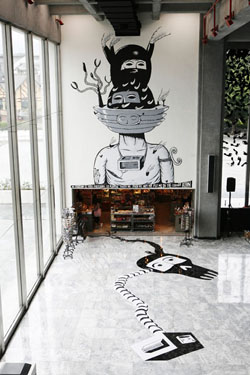

 One of the more beguiling artist’s books to appear in the past couple of years is a modest, even tiny, comic self-published by Eko Nugroho, called Fight Me. While appearing by its cover to be endorsing violence, the short, erratic tome in fact has very little narrative of any kind, or recurring characters. It is simply a collection of assorted images, strewn together with random bits of language to produce an almost surreal elision of specific meanings. Like much of Nugroho’s work, Fight Me seizes upon the crisis of the moment -- fundamentalist-driven violence – as a way of simultaneously engaging, provoking and titillating his viewers into searching for the key to the puzzle, while reflecting, however obliquely, on the larger issues that prompted us to hurry and flip open the book’s cover.
One of the more beguiling artist’s books to appear in the past couple of years is a modest, even tiny, comic self-published by Eko Nugroho, called Fight Me. While appearing by its cover to be endorsing violence, the short, erratic tome in fact has very little narrative of any kind, or recurring characters. It is simply a collection of assorted images, strewn together with random bits of language to produce an almost surreal elision of specific meanings. Like much of Nugroho’s work, Fight Me seizes upon the crisis of the moment -- fundamentalist-driven violence – as a way of simultaneously engaging, provoking and titillating his viewers into searching for the key to the puzzle, while reflecting, however obliquely, on the larger issues that prompted us to hurry and flip open the book’s cover.
Indonesia, where Nugroho lives and works, is a country still in the drawn-out process of exploring and working through the various kinks that go along with being a fully participatory democracy which is not even a decade old. Like nearly every other artist of his generation, Nugroho is fully caught up in the very public process of defining what it means to be an artist in a society where freedom of expression is still a new and untested concept. Not surprisingly in a fluid situation like this one, Nugroho prefers not to stick to any one artistic medium, but to spread his considerable artistic gifts as widely as possible, creating short animations, handbills, posters, comics, stickers, murals and even embroideries, along with the more conventional drawings and paintings.
Dramatic shifts in scale are one aspect of his work that Nugroho has mastered almost effortlessly, a facility that has led to his being invited to produce a large-scale mural for the TFAM lobby, on a wall whose massive blankness is belied by the fact that it has nearly always remained untouched, and so remains practically invisible. Even at such an immense scale, Nugroho’s figures project a genuine intimacy, as if they had leaped unaltered from the pages of his private sketchbook. Such directness of approach, which seems equally grounded in a desire to make art that can be enjoyed by the masses, gives the viewer an opportunity to indulge in a certain universality of graphic invention, which in today’s fractured culturescape seems to be an increasingly exotic perspective.